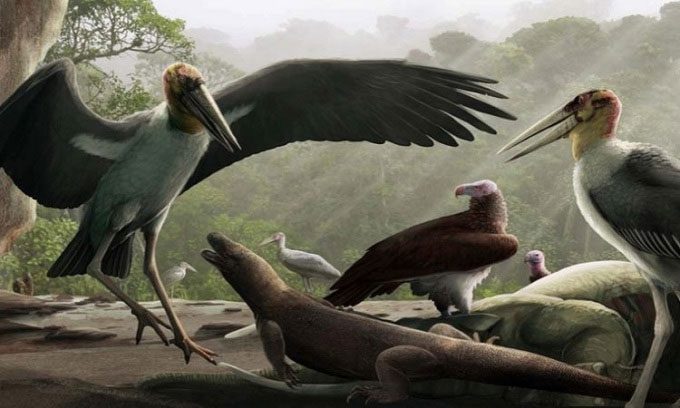Archaeologists Discover 1.5-Meter Tall Flores Stork on the Island of the Same Name, Specialized in Scavenging Animal Remains, Potentially Leading to Its Extinction.

Reconstruction of the giant stork of Flores Island. (Photo: Gabriel Ugueto)
In ancient Flores, an island in eastern Indonesia, the hobbit (Homo floresiensis) coexisted with a species of giant stork. Standing over 1.5 meters tall, the Leptoptilos robustus of the Stone Age was significantly larger than the H. floresiensis, which stood at only 0.9 meters, living over 60,000 years ago. Previously, paleontologists believed L. robustus was a flightless bird adapted to the island’s isolated ecosystem. However, new analyses of fossilized wing bones, published on July 13 in the journal Royal Society Open Science, have changed their perspective. Despite its large size, a wingspan of 3.7 meters likely enabled the ancient stork to fly high.
This new discovery has prompted paleontologists to reconsider the body structure and behavior of L. robustus. Instead of hunting small prey, their research suggests that these birds may have been scavengers, similar to many prehistoric flying storks, akin to the marabou stork found in the modern-day Saharan region. The Flores stork’s preference for carrion could even explain its extinction.
The research team was able to create new images of the giant Flores stork using 21 bones, including wing bones found in Liang Bua Cave—a place where they sought shelter from the heat and drank water. However, predators could take advantage of the situation to easily catch prey. The remains of animals killed by Komodo dragons or H. floresiensis could attract the storks to feed on leftover meat. Subsequently, they might have died in the cave and become buried there, turning into fossils over tens of thousands of years.
The first bones of L. robustus were discovered in 2004, but it took many years for experts to collect and classify more fossils from this species. The new research by Meijer and colleagues helps create a more complete picture of the species. If the Flores stork were flightless, its wing bones would be smaller and show signs that they were no longer used for flying. When the wing bones of the Flores stork were identified in the collection from Liang Bua Cave, Meijer noted that they resembled flight-capable wing bones. This discovery led the research team to alter their views on this giant bird.


















































